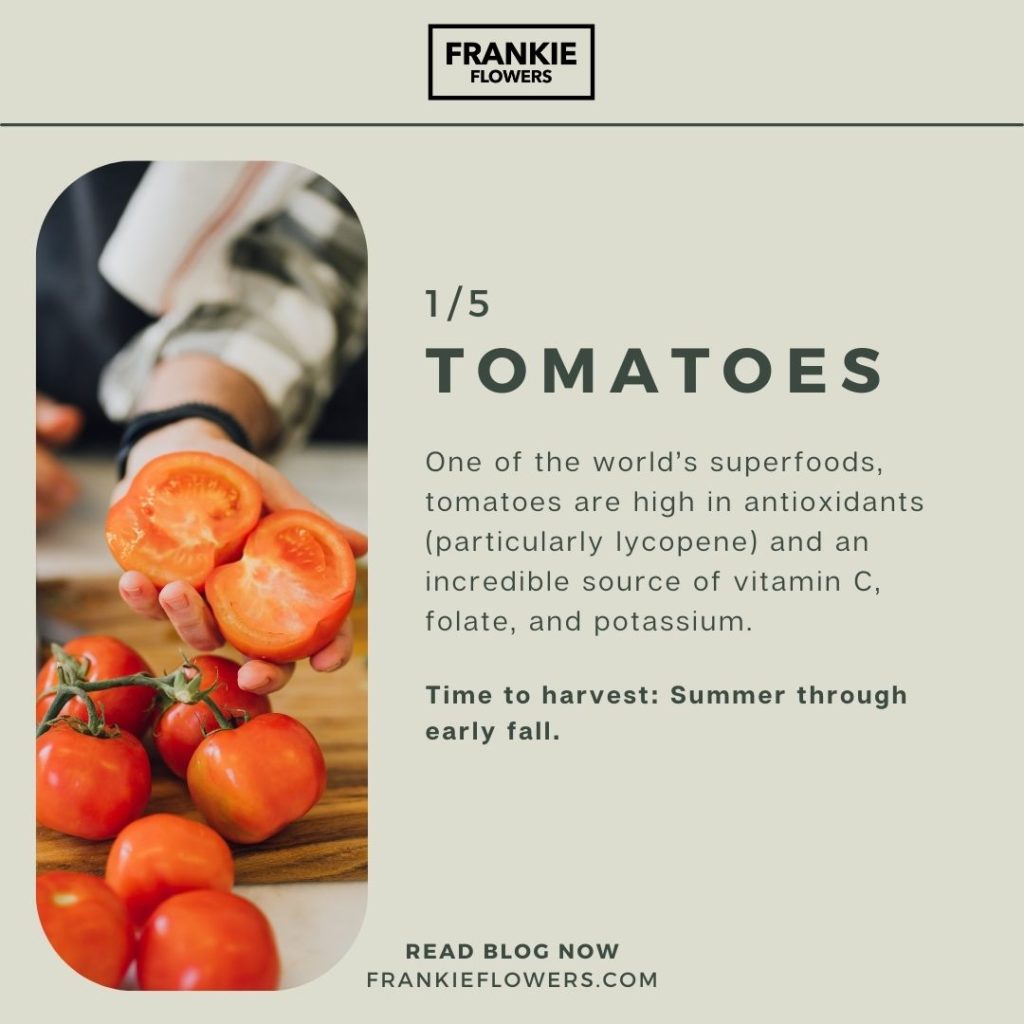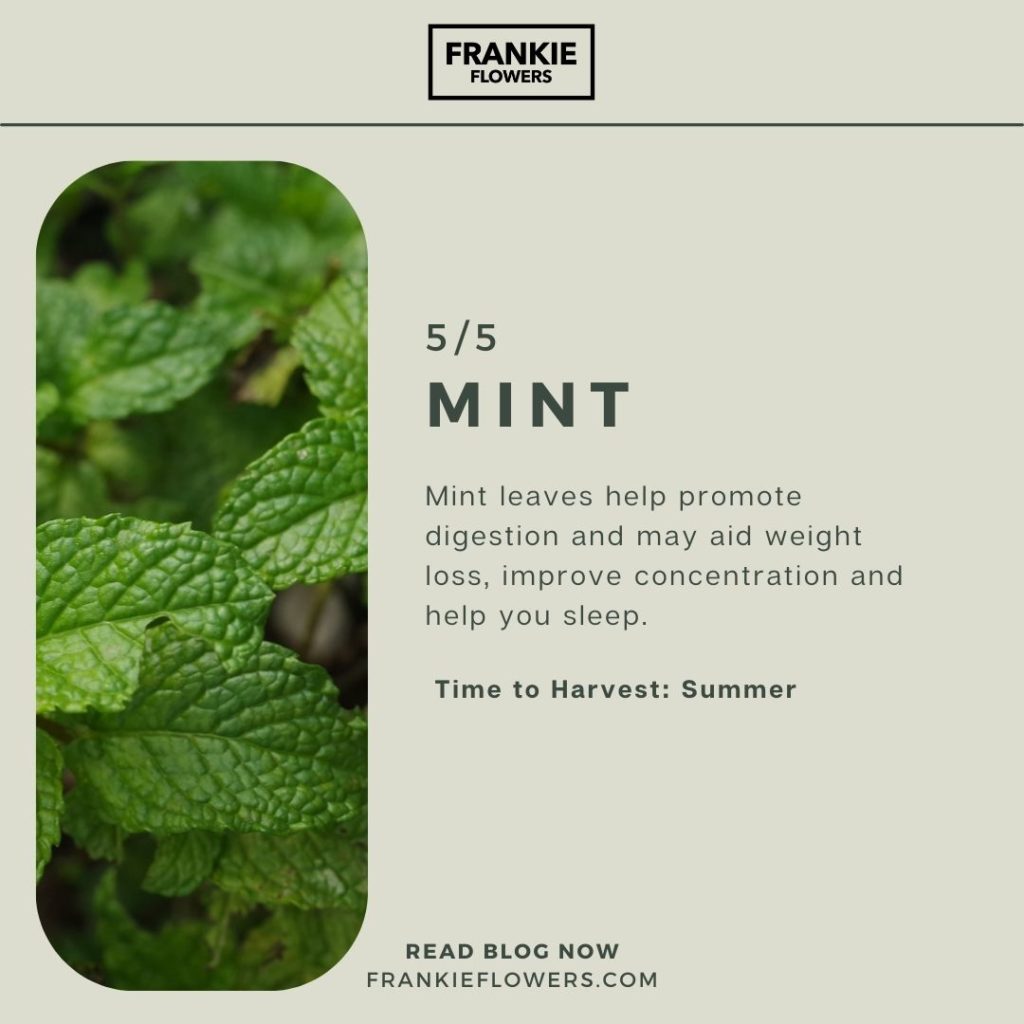5 Powerful Plants to Start in Your Garden This Spring
Healthy eating starts in the garden. Plants, herbs, fruits, and vegetables have incredible healing properties. If you are what you eat, make sure you’re getting enough superfoods!
We all know the importance of a healthy diet. With a bit of love and patience, there is an abundance of healthy vegetables you can easily grow, either in your garden or patio pots. The bonus of growing your own delicious healing plants is that you control the types of fertilizers, soil, and pesticides used.
Frankie’s Top 5 Healing Foods to Grow in Your Garden

1. Tomatoes
Benefits: One of the world’s superfoods, tomatoes are high in antioxidants (particularly lycopene) and an incredible source of vitamin C, folate, and potassium.
Planting
Plant tomatoes after the risk of frost, in a spot where they’ll get at least 6 hours of sunlight a day. There are endless varieties from bushes to vine types, whether growing in pots or the garden. When planting, remove the bottom leaves of the seedling and cover the lower 1/3 of the stem with rich soil.
Tips for Success
- Add a handful of crushed eggshells to the soil when planting — they will add calcium and minimize the chances of getting blossom end rot, a common disease affecting tomatoes as they mature.
- To improve the flavour of your tomatoes, plant them close to basil.
- Water in the morning using a soaker hose rather than a sprinkler to avoid splashing water on the leaves or fruit.
Time to harvest: Summer through early fall.

2. Swiss chard
Benefits: Known as an antioxidant powerhouse with anti-inflammatory properties, Swiss chard is also a good source of calcium, magnesium, vitamin D and vitamin K.
Planting
Sow Swiss chard seeds directly into the garden two weeks before the last risk of frost. Unlike most other leafy greens, this annual vegetable will produce a second, third, fourth, or even fifth harvest through the growing season.
Tips for Success
- For a range of colourful Swiss Chard stalks, including white, red, orange, and yellow, look for the Bright Lights variety.
- Sow again in late summer for an additional fall harvest
- Remove weeds weekly as they compete for nutrients and moisture (add mulch to set yourself up for success)
- If grown in containers, fertilize at least twice per month with a fish emulsion or 20-20-20 fertilizer
Time to harvest: Summer through fall

3. Kale
Benefits: One of the most popular superfoods right now, Kale boasts high levels of calcium, vitamin C, vitamin A and vitamin K. It is also a great source of ALA (an omega-3 fatty acid healthy for your heart and brain).
Planting
From pots to plots, this annual plant is easy to grow. It enjoys rich, well-drained soil, and while it can be grown from seed, I recommend that newbies plant kale transplants, which you can find at your local gardening centre. For best results, plant Kale in direct sun in early spring.
Tips for Success
- Keep your eyes out for green caterpillars and cabbage moths, a species of white butterfly that will eat your leafy greens. Spray an insecticidal soap monthly to prevent and control these creepy crawlers.
- Water deeply and infrequently and only fertilize when planted in containers or poor soils.
- Use mulch to help keep weeds out.
Time to Harvest: Can be harvested within as little as 6-8 weeks.

4. Rhubarb
Benefits: Herbalists have traditionally used rhubarb as a laxative or to treat liver disease. It also contains significant amounts of vitamins C, K, B-complex and the essential minerals calcium, potassium, and manganese. (note *The stalks are tasty, but the leaves are toxic.)
Planting
This large leafy perennial isn’t for patios, terraces, or small gardens. It needs lots of space and is fast-growing, so it is best suited for large gardens with well-drained soil rich in organic matter. Purchase rhubarb crowns from garden centres in early spring and plant in full sun.
Tips for Success
- Remove flower stalks when they appear, and any yellowing or dead leaves
- Cover roots using 15-20cm of leaves or clean straw in fall to protect against snow and frost. Remove the mulch in spring.
Time to Harvest: I recommend waiting until the following spring season before harvesting stalks to give ample time for root establishment.

5. Mint
Benefits: Mint leaves help promote digestion and may aid weight loss, improve concentration and help you sleep.
Planting
Mint should be sold with a warning! It grows almost too easily and will overtake if given a chance. Instead of planting directly in the garden, grow mint in a pot on your patio. It grows best in the sun but will tolerate partial shade.
Tips for Success
- I recommend slightly larger pots with greater soil mass as they won’t dry out as often.
- Use a rich potting soil and fertilize regularly during the growing season.
Time to Harvest: Summer

Growing healthy food in your garden is a rewarding adventure! The healing power of food is truly an incredible thing. So let’s roll up our sleeves, head outside, and get growing.

WANT MORE PLANT POWER INFORMATION?
To learn more about growing your own food, grab a copy of “Power Plants: Simple Home Remedies You Can Grow.”
